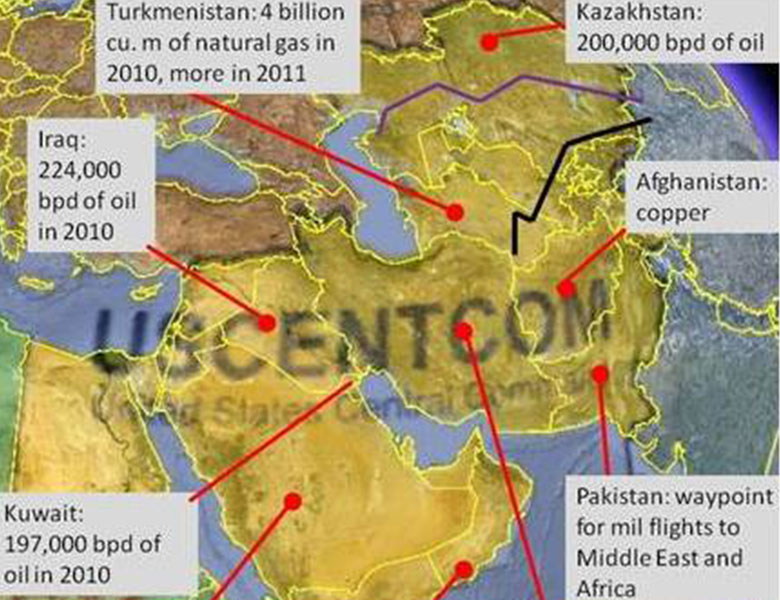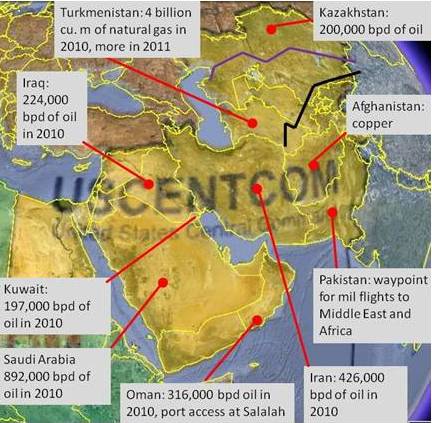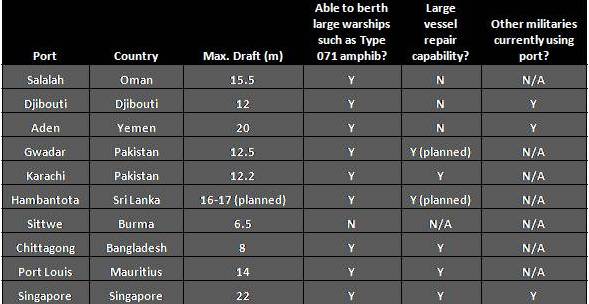China’s recent operation to evacuate its citizens in Libya saw PLA ships and aircraft pass through the U.S. Central Command’s (CENTCOM) area of responsibility (AOR), suggesting that contact between the U.S. and Chinese militaries in the Middle East is likely to increase. To help policymakers, we give a brief rundown of China’s strategic and economic interests in countries within the CENTCOM AOR. As Exhibit 1 (below) shows, energy is a key interest, with countries in the AOR accounting for more than 2.2 million bpd of oil supply to China in 2010 (~45% of China’s total oil imports).
Exhibit 1: Select Chinese strategic and economic interests in the CENTCOM AOR
Source: CNPC, Naval War College Review, OilCapital, China SignPost™
China’s crude oil import volumes from the region are likely to grow this year, particularly with the disruptions to Libyan crude oil supplies and the decision of other OPEC members such as Saudi Arabia to increase production to try and keep markets stable. Kazakhstan is also important as both a crude oil supplier and a transit route for natural gas from Turkmenistan.
Chinese interest in natural resources within CENTCOM’s AOR now extends much deeper than simply pulling tankers up to oil wharves. China National Petroleum Corporation (CNPC) has become a major player in developing oilfields in southern Iraq, while China Metallurgical Group Corporation is developing the Aynak copper deposit in Afghanistan, which would hold 11 million tons of the metal, equal to 1/3 of China’s known copper reserves, according to The New York Times.
China has broader security and economic interests in the region, including the well-being of PRC nationals working in these countries on major infrastructure and energy/mining projects, as well as private businesspeople. Officials in Kyrgyzstan say as many as 100,000 Chinese lived in the country prior to the ethnic violence that rocked the country in June 2010. Many have likely returned since the turmoil ended. Kazakhstan likely also hosts a sizeable population of Chinese nationals. In the Gulf area, as many as 200,000 Chinese citizens live in the UAE, according to The China Post. As the Libya NEO operation demonstrated, Beijing is now much more willing and able to actively safeguard Chinese citizens overseas than was the case even a few years ago.
In addition, the Chinese military is increasingly conducting long-range air operations through airspace in the CENTCOM AOR. For instance, the SU-27s involved in the 2010 exercise Operation Anatolian Eagle reportedly made refueling stops in Pakistan and Iran on their way to Turkey, according to Hurriyet. Also, during the September 2010 Peace Mission multilateral exercise, Chinese J-10s operating from bases in Xinjiang conducted a 2,000km strike mission with live ordnance against targets in Kazakhstan that included aerial refueling, according to Sina.com. Finally, the PLA Air Force IL-76 transports that evacuated Chinese citizens from Libya transited the airspace of several countries in the AOR on their way to and from Libya.
On the naval side, the PLA navy’s anti-piracy mission in the Gulf of Aden is making substantial use of the ports of Aden, Djibouti, and Salalah, Oman for refueling and replenishment of its forward-deployed ships. In an excellent analysis in the Winter 2011 issue of Naval War College Review, Navy analyst Dan Kostecka points out that “every vessel in the second, third, fourth, fifth, and sixth rotations called into Salalah for resupply between June 2009 and August 2010.” This pattern has continued into the seventh (ongoing) deployment, with frigate Xuzhou being resupplied in Salalah 31 days before arriving off Libya to escort civilian vessels carrying Chinese evacuees.
Kazakhstan, Kyrgyzstan, Uzbekistan, and Tajikistan are also member of the Shanghai Cooperation Organization (SCO). Interpretations vary as to the SCO’s ultimate strategic goals regarding its potential as a regional counterweight to the U.S. and the organization clearly focuses on counter-terrorism and other security matters. China is especially interested in ensuring that Kazakhstan and Kyrgyzstan do not become safe havens for Uighurs in Xinjiang/Western China who wish to rebel against Beijing.
Policy recommendations
China’s economic and military activities within the CENTCOM AOR are either conducted with sovereign partners or in international waters in the case of the anti-piracy mission. As such, they are not subject to any U.S. diplomatic or military jurisdiction. We view China’s demonstration of its nascent expeditionary capability during the Libya crisis as a positive development. A more muscular Chinese foreign military posture may actually facilitate cooperation against non-traditional security threats. Our position is that in coming months, it is worth discussing the PLA air and naval deployments with Chinese diplomatic and security officials to explore ways of better coordinating bilateral and multilateral military cooperation. The Chinese side may well reject a request for such discussions, but the issue is important enough to warrant opening lines of communication.
Initial engagement with the PLA in the region is likely to be most fruitful via U.S. Fifth Fleet. This is because naval operations are thus far solely in international waters, while many of China’s land-based economic and military interactions within the region are with countries such as Iran, which is deeply hostile to the U.S.; and Pakistan, where China is unlikely to be willing to openly cooperate due to the risk that the Pakistani public would perceive it as an ally of the domestically unpopular U.S. government.
China will be subtle as it considers an increased presence in the region, commensurate with its rising economic and strategic interests. Beijing will most likely pursue a “places, not bases” approach, since building a full-fledged military bases arouses fears and suspicion that have high diplomatic costs, while simple access for replenishment and refueling and repair of ships and aircraft would be sufficient to support the PLA’s current regional activities, as well as those likely to occur in the next five years.
Areas for potential deepening of PLA engagement in the reading that merit close watch in coming years include: Tanzania, Kenya, Madagascar, Djibouti, Salalah (Oman), Aden (Yemen), Gwadar and Karachi (Pakistan), Chittagong (Bangladesh), Hambantota (Sri Lanka), Mauritius, where Port Louis has sufficient draft to accommodate a large warship, Sittwe (Burma), and Singapore. Some of these ports are outside of CENTCOM’s AOR, but deserve attention due to their potential ability to support PLA military operations within the AOR. Exhibit 2 (below) outlines some potential “places” the PLA might be able to utilize for naval logistical support in the Indian Ocean region. The table also displays each port’s maximum draft restriction and if known, the capacity of ship repair facilities and whether or not foreign militaries already utilize the facility for replenishment and repair services.
Exhibit 2: Potential “places” for the PLA Navy in the Indian Ocean
Source: Andrew Erickson (chapter in PLA at Home and Abroad), World Ports, U.S. Navy, Myanmar Port Authority, Chittagong Port Authority, China SignPost™
Additional Reading
Gabe Collins and Andrew Erickson, “The PLA Air Force’s First Overseas Operational Deployment: Analysis of China’s decision to deploy IL-76 transport aircraft to Libya,” China SignPost™ (洞察中国), No. 27 (01 March 2011).
Gabe Collins and Andrew Erickson, “Missile Frigate Xuzhou Transits Suez Canal, to Arrive off Libya ~Wednesday 2 March: China’s first operational deployment to Mediterranean addresses Libya’s evolving security situation,” China SignPost™ (洞察中国), No. 26 (27 February 2011).
Gabe Collins and Andrew Erickson, “China Dispatches Warship to Protect Libya Evacuation Mission: Marks the PRC’s first use of frontline military assets to protect an evacuation mission,” China SignPost™ (洞察中国), No. 25 (24 February 2011).
For analysis of Beijing’s interests in Libya and the surrounding region, see Gabe Collins and Andrew Erickson, “Libya Looming: Key strategic implications for China of unrest in the Arab World and Iran,” China SignPost™ (洞察中国), No. 24 (22 February 2011).
For early projections regarding Chinese efforts to protect citizens overseas, see Andrew Erickson and Gabe Collins, “Looking After China’s Own: Pressure to Protect PRC Citizens Working Overseas Likely to Rise,”China SignPost™ (洞察中国), No. 2 (17 August 2010).




